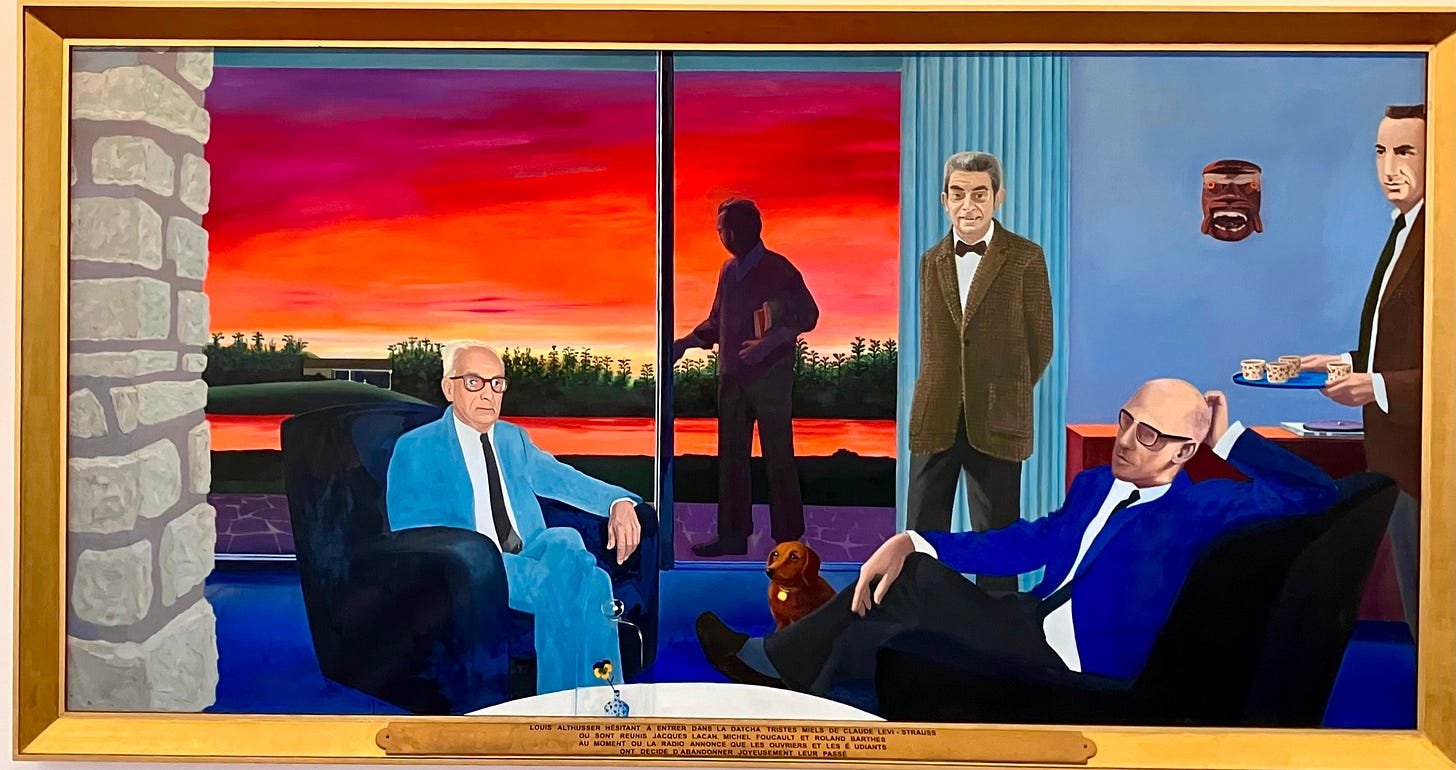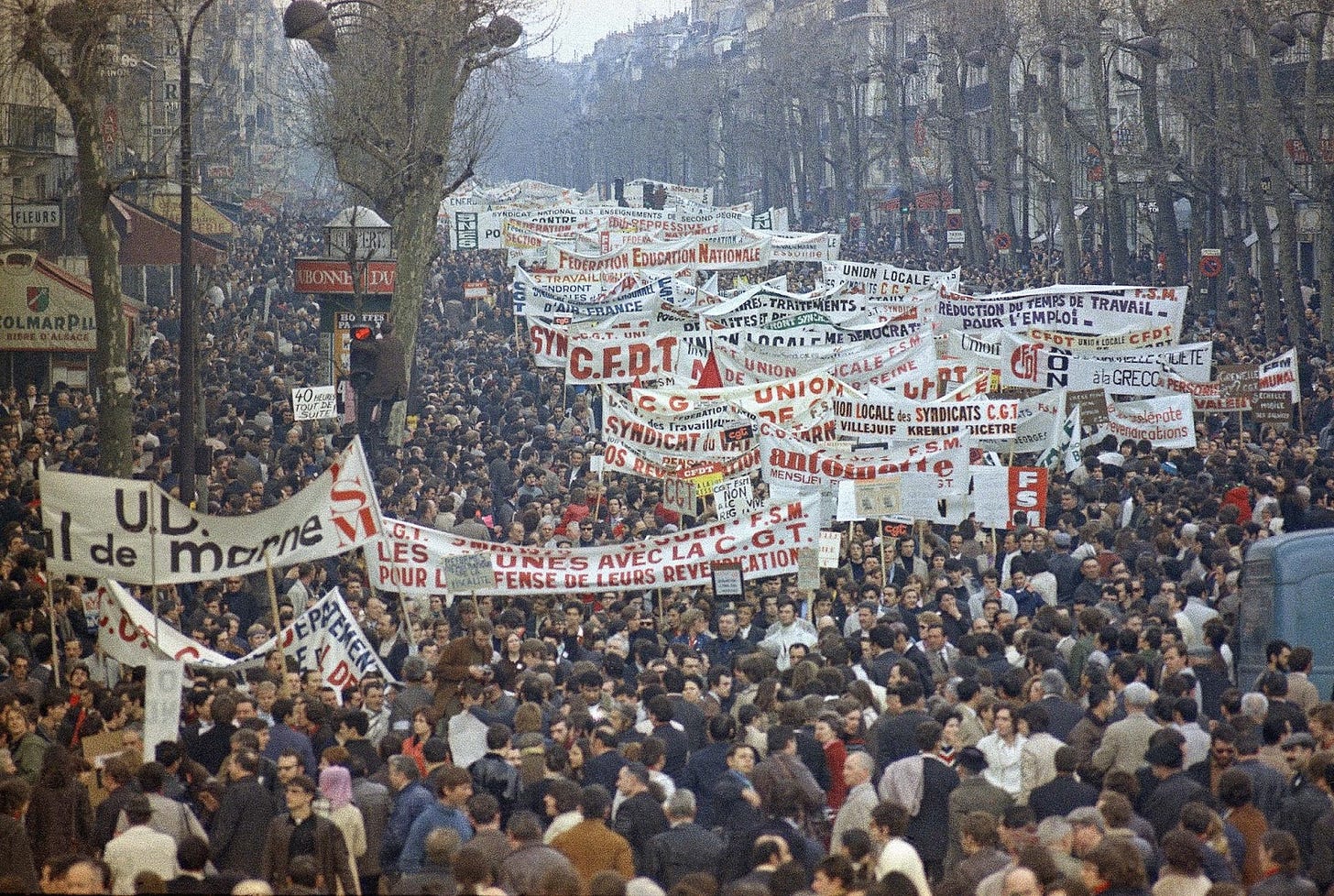Can you believe this:
France’s railway company, SNCF, has had strikes every year since 19471.
My guess? If you’ve been to France, you can believe it.
I should say we were at The Centre Pompidou—that building with all the pipes and escalators and so on on the outside—a modern and contemporary gallery of Modern and Contemporary Art—and looking at this huge painting (2m x 4m) by Spanish artist Eduardo Arroyo (and others: a collaboration).
Bunch of guys sitting around in some Mid-Century Modern place: could easily be Don Draper and his advertising buddies, from the TV series Mad Men, figuring how to sell more Lucky Strike cigarettes.
Here’s something I read:
You cannot understand France today without understanding the French revolution2.
That’s the one in 1793-94 when about 17,000 royals and nobles completely lost their heads. Liberty, Equality, Fraternity—democracy—and all that. Which was not the revolution that Les Misérables was based on: that was the June Rebellion, about forty years later. And then there was the Paris Commune, in 1871, when 10-20,000 people were killed.
Or go back to the thirteenth century and the University of Paris strike, or forward to 2018 and the Yellow Jackets (Gilets jaunes) movement, or 2024 and the farmers’ protests. A never-ending story of civil unrest. C'est ça, la France!
So, back to the painting…
Turns out, the men shown are all famous philosophers. The one outside, in shadow, is the most famous. He’s Louis Althusser, the leading intellectual in the France Communist Party at the time (1960s). The names of the others are all on the plaque.
Would you mind reading up what they were on about and getting back to me? That would help. (“Post-structuralism is a philosophical movement that questions the objectivity or stability of the various interpretive structures that are posited by structuralism and considers them to be constituted by broader systems of power.”)
They are pictured at a holiday home: the short title of the painting is The Datcha (the country house)3. Which is significant: it means they were not in Paris…
Because in Paris—it was May, 1968—there was another uprising. A big one. Started by students, but taken up by the workers: nine million of whom went on strike…for a month. An uprising inspired by the Marxist intellectuals in the painting…their promise of the ‘dictatorship of the proletariat’: the creation of a class-less society.
But they—the intellectuals—were not there.
The painting, in truth, is an attack on the five. It lumps all the great minds of the moment together…cut off from the world, timid, without courage4.
In the datcha. From here, wrote one of them, it looks like a great mystery. Be careful what you wish for.
The mass walkouts and demonstrations of Mai ‘68 were ultimately successful (one historian concludes) as they achieved a thirty-five per cent rise in the minimum wage as well as undermining the legitimacy of President Charles de Gaulle, who stood down the following year5.
Every picture tells a story: mysterious often to my undeveloped understanding and imperfect feelings, yet ever profoundly interesting6. And there we stood, gazing at this mysterious painting. With no idea, in that moment, of the story it told.
Now, though, perhaps we understand France just a little more. Strikes and all.
Next week: Our Lady of Paris
Ione Gildroy, Retrospect Journal
Political scientist Bruno Cautres in the same article.
Its full name is Louis Althusser hesitating to enter the datcha Tristes miels by Claude Lévi-Strauss where Jacques Lacan, Michel Foucault and Roland Barthes are gathered at the moment when the radio announces that the workers and students have decided to joyfully abandon their past.
Bernard-Henri Lévy, who rediscovered the painting.
Ione Gildroy, Retrospect Journal. The new president would be Georges Pompidou, whose gallery where the painting now is.
Charlotte Brontë from Jane Eyre






Always learning from you Chris Bray.
Always learning myself, Sal!